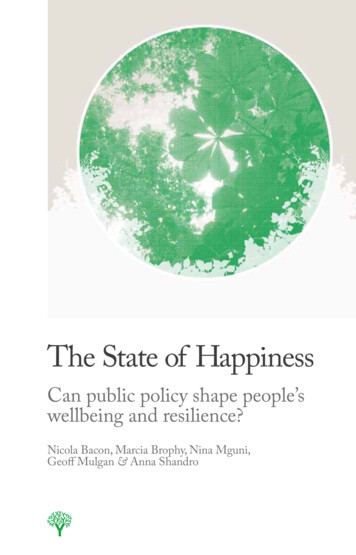
Transcription
The State of HappinessCan public policy shape people’swellbeing and resilience?Nicola Bacon, Marcia Brophy, Nina Mguni,Geoff Mulgan & Anna Shandro
About the Young FoundationThe Young Foundation combines creativity and entrepreneurship to tacklemajor social needs. We work on many different levels to achieve positive socialchange – including advocacy, research and policy influence as well as creatingnew organisations and running practical projects. The Young Foundation benefitsfrom a long history of social research, innovation and practical action by thelate Michael Young, once described as “the world’s most successful socialentrepreneur” who created more than 60 ventures which address social needs.www.youngfoundation.orgThe Local Wellbeing ProjectThe Local Wellbeing Project is a unique, three-year initiative to explore how localgovernment can practically improve the happiness and wellbeing of its citizens.The project brings together the Young Foundation with three leading localauthorities, Manchester City Council, Hertfordshire County Council and SouthTyneside Metropolitan Borough Council; Professor Lord Richard Layard from theLondon School of Economics, and the Improvement and Development Agencyfor local government. The project is also backed by key central governmentdepartments.
Understanding happiness and wellbeing164Measuring wellbeing285What is the relevance of wellbeing to key areas of publicpolicy?5.1 Lifestages and wellbeing5.1.1 Family and childhood5.1.2 Education5.1.3 Work5.1.4 Ageing5.2 Society and wellbeing5.2.1 Health5.2.2 Sports and the arts5.2.3 Community5.2.4 The environment4042424955616565707180Conclusions: Implications for public policy866The state of happiness: Can public policy shape people’s wellbeing and resilience?First published in Britain in 2010 byThe Young Foundation18 Victoria Park SquareLondonE2 9PFUKCopyright resides with the Young Foundation. 2010.A CIP catalogue record for this book is available from the British LibraryISBN 978-1-905551-12-5Printed by Solopress on 9lives Offset paper (FSC certified 100% recycled fibre) using vegetable inks.Cover illustration by Claire Scully. Designed and typeset by Effusion.3
The State of HappinessAcknowledgementsAcknowledgementsMany thanks to our funders:yy Hertfordshire County Council, Manchester City Council and South TynesideMetropolitan Borough Councilyy The Improvement and Development Agency for local government (IDeA)yy The Audit Commissionyy Communities and Local Government (CLG)yy Department for environment, food and rural affairs (Defra)yy Department for Children, Schools and Families (DCSF)yy Department of Health (DH)yy The Learning and Skills Councilyy The Local Government Associationyy The National Apprenticeship ServiceAnd to the key contacts from the project partners whose support, advice andinspiration have been critical to the success of the Local Wellbeing Project:Andrew Simmons, Hertfordshire CC, and his predecessor, Alan DinningGeoff Little and Sharon Kemp, Manchester CCIrene Lucas (now at CLG), Diane Wood (now at Cumbria County Council) andTony Duggan, South Tyneside MBCAdrian Barker and Vicki Goddard, from IDeAProfessor Lord Richard Layard, LSEThe Advisory Board was chaired by Lucy de Groot (until 2009) and thenAndrew Cozens, both from IDeA.Many other individuals in the three areas, in government and other agencies havecontributed enormously to the work of this project. They are all listed at the end ofthe report.45
The State of Happiness1 SummaryDemocratic governments have always beeninterested in actions that might increase thewellbeing of their citizens. But while in thepast this was a broad and unfocused goal, todaythere is increasing evidence and understandingabout what shapes wellbeing, from economics,psychology, philosophy and political science.There is also a growing body of knowledgeand experience of how it can be measured.SummaryMany initiatives around the world testify to the growing importance of wellbeingas an explicit goal of policy, including President Sarkozy’s commission intomeasuring progress,1 the growing reorientation of healthcare towards wellbeing inmany countries, and moves by national governments including Canada, Australiaand the UK to invest in different ways to measure wellbeing.2,3 The recentrecession might have been expected to diminish interest in wellbeing, whichcould have been seen as a luxury for times of plenty. Instead it has generated asharper focus on what spending does to influence wellbeing, how to make peopleresilient and how to mitigate the factors that harm wellbeing.However, serious work on policy options has lagged behind academic analysis ofwhat causes happiness. There is still little solid experience of reshaping welfare,education and other fields of government action to promote wellbeing. The LocalWellbeing Project has been one attempt to fill the gap – a partnership between theYoung Foundation, Professor Lord Richard Layard at London School of Economics(LSE), the Improvement and Development Agency for local government (IDeA),and three leading local authorities: Hertfordshire County Council, Manchester CityCouncil, and South Tyneside Metropolitan Borough Council. It has shown thatwellbeing can be made a practical policy goal, both nationally and locally, andthat it provides a very different way of thinking about changing needs to traditionalapproaches.The project has also provided a vehicle for looking at many of the differentdimensions of wellbeing – including its overlaps with sustainability (and thetensions there are as well); the role of parenting and families; neighbourliness;and options for measurement. Annex 1 provides a comprehensive overview.In this report we take a broader look at how a wellbeing focus can be integratedinto public policy more systematically, and at what is known but also what isnot known. We show that the language of wellbeing encompasses a range ofdifferent things, and that as the policy debate becomes more sophisticated it willdifferentiate between the different dimensions of wellbeing (happiness, fulfilment,life satisfaction) rather than seeing these as a single thing. We look at thechallenges of measurement, and also suggest useful ways to measure wellbeingat a local level, emphasising that the greatest insights come from disaggregatingdata rather than aggregating it.We also show where we think there is most potential for public policy toinfluence wellbeing – linking better understanding of wellbeing, and policies topromote it, with a more sophisticated view of future-readiness and the policiesthat are needed to promote resilience by reinforcing strengths and remedyingvulnerabilities. This is becoming ever more important in the context of therecession and serious public spending constraints.We also address the common arguments against taking wellbeing seriously. Thefirst is that wellbeing is unknowable and unmeasurable. It is true that wellbeing67
The State of Happinessis difficult to measure. But work over the past few years by many of the world’sleading statisticians has shown that wellbeing in all of its dimensions is notinherently harder to measure than economic prosperity, health or the environment(another report by the Young Foundation published in December 2009, ‘Sinkingand Swimming: Understanding Britain’s unmet needs’, shows in detail how thewellbeing of the population can be measured in many different dimensions).A second set of arguments claims that public policy is inherently ill-suited toinfluencing wellbeing. Governments are poorly placed to understand wellbeingand their blunt powers and programmes are unlikely to influence it. There arecertainly good reasons for believing that wellbeing should not be the only goal ofpolicy. But there is strong crossnational evidence that wellbeing correlates fairlyclosely with particular forms of government, and, to a lesser extent, with theresults of particular kinds of government policy. Given what we know, it would bevery surprising if policy did not have a significant influence.Summaryyy parenting programmes that deliberately try to support parents’ wellbeing aswell as their childrens’yy planning, transport and school policies that encourage more exerciseyy systematic support to isolated older people to help them create and maintainsocial networksyy transport and economic policies that encourage lower commuting timesyy apprenticeships and other programmes for teenagers that strengthenpsychological fitness.These are just a few examples. Our hope is that the field will evolve and learnquickly both about what can, and what cannot, be achieved.A third set of arguments claim that any overt attempts to influence wellbeing willfail, whether in individuals lives or in societies. As we show, there is some truthto this view: happiness is more often achieved as a side product of other goalsrather than as an end in itself. But all of the policy measures set out here can bejustified on grounds other than wellbeing. Any actions which were only justifiedas influencing wellbeing might indeed be suspect.Finally, there are the arguments which point to the significant genetic influenceon wellbeing and to the evidence that most people oscillate around a set point ofhappiness. Both sets of evidence at first glance suggest that public policy mighthave little impact. But crossnational evidence, again, suggests that, while there isa genetic influence on wellbeing and individuals tend to move around a set point,public policies can and do influence the overall distribution of wellbeing in apopulation, moving most people up (or down). In other words, average set pointswill tend to be higher in a nation (or a locality) with policies that support wellbeing.What follows is a snapshot of a field in rapid development. The translation ofanalysis of wellbeing into policy is only beginning. But as we show in this reportthere are many dozens of practical projects underway, most below the radarof national government and the national media, that are trying to influencewellbeing.These point to some priorities for policy, such as:yy lessons in schools to build up children’s resilienceyy health provision that gives as much weight to patient experience and wellbeingas to clinical outcomes (for example, through paying more attention to low levelsocial supports)yy community policies that encourage neighbours to get to know each other89
The State of Happiness2 IntroductionHappiness is the meaning and the purpose of life,the whole aim and end of human existenceAristotleDemocratic governments naturally try topromote a better life for their citizens. It ishard to imagine political parties being electedif they did not offer at least some prospect ofimproved wellbeing. And while government– central or local – cannot directly makeus happier or more engaged, it does shapethe economy, culture and society in whichwe live through policies and decisions onwhere to spend finite resources, and lawsthat regulate what can and cannot be done.IntroductionGovernment policies over the last few decades have primarily focused onpromoting economic growth, ensuring a reasonable distribution of resources andopportunities, and protecting people from the major threats against which theycannot protect themselves.But there has always been a parallel emphasis on wellbeing, from the 19thcentury utilitarians to 20th century liberalism and the socialism of figures such asAnthony Crosland.4 Many believed that the emphasis on material growth wouldbe temporary, and that once basic needs were met attention would turn to otherthings. In the 1930s Keynes wrote: ‘assuming no important wars and no importantincrease in population, the economic problem may be solved, or be at least withinsight of solution, within a hundred years. This means that the economic problemis not – if we look into the future – the permanent problem of the human race.’Seventy years later the economic problem has not been solved, material scarcitycontinues to exist for a large proportion of the world’s population. But in moreprosperous countries it is no longer the central problem. Instead, other issuesare equally important. These include crime and safety, health, learning andthe environment. All now have an important dimension that is about wellbeing:how can healthcare make people happy as well as stopping sickness? How caneducation prepare people for a good and happy life?This shift is a natural one for democracy. It has involved policy becoming moreattuned to what the public cares about. In the past many policy fields werejustified in instrumental terms. In the 19th century military prowess dominated,and issues as varied as education and public health had to be justified in termsof their impact on nations’ relative military performance. In the 20th centuryeconomic prowess filled a similar position, and innumerable education policies,for example, had to be justified in terms of their impact on economic growth.Today politicians and policy-makers can be more direct and more honestin describing wellbeing as a legitimate goal in itself. However, the policytools for influencing wellbeing are at an early stage of development. Reliablemeasurements are fairly recent – which means that few policies have been testedfor their impact on wellbeing.This report describes the state of play in academic and practical knowledge aboutwellbeing, including the experience of the Local Wellbeing Project in the UK,one of the few programmes explicitly focused on influencing wellbeing across arange of policy fields. It also includes some UK and international examples thatdemonstrate the range of practical tests of wellbeing theory throughout the world.The report focuses on the key areas where the evidence is strongest, where thereis most to learn from practical experience, and where public policy is likely havethe greatest traction.1011
The State of HappinessThe Local Wellbeing Project – a partnership between the Young Foundation,Professor Richard Layard at the LSE Centre for Economic Performance, IDeA,and three leading local authorities: Manchester City Council, South TynesideMetropolitan Borough Council and Hertfordshire County Council – began in2006.This ambitious programme aimed to find ways to accelerate local government’sinvolvement in actions to increase wellbeing, through practical trials and adaptingmainstream services.‘Inspired by Lord Richard Layard and energised by the Young Foundationand colleagues in South Tyneside and Hertfordshire, we in Manchester havetaken happiness very seriously. Being positive, having high aspirations,optimism that your aspirations can be achieved and the resilience toovercome the temporary setbacks are all attributes which we believe canmake a big difference to the prospects of Manchester people, not leastthose living in the most deprived neighbourhoods. This is how we interpretwellbeing. It’s taken some guts to try these ideas out through initiativessuch as the Resiliency Programme for secondary school children, but webelieve we are beginning to see the evidence that these approaches canmake a difference to the bottom line of better tangible outcomes for localpeople.’– Geoff Little, Deputy Chief Executive, Manchester City Council‘In South Tyneside, we are passionate about the role that culture andwellbeing plays for both individuals and communities. We have workedclosely with local communities and national and international experts toidentify what it is that gets in the way of wellbeing. We have developedan approach that we believe is right for the people of South Tyneside. Weare grateful for the support of the Young Foundation and IDeA. We’vealso learned a huge amount by working with other experts, including DrMartin Seligman of University of Pennsylvania and Lord Richard Layard,Founder-Director of the London School of Economics’ Centre for EconomicPerformance. Our vision is to strengthen wellbeing and enhance our senseof place by inspiring and engaging people in a wide range of activity and bymaking the most of our world-class heritage, breathtaking natural assets,events and festivals. I would like to extend my personal thanks to thosepeople who have made this happen - the local partners and practitionerswho have made a real difference by delivering a range of services that havehelped local people fulfil their potential and enjoy life to the full.’Councillor Tracey Dixon, Lead Member Culture and Wellbeing, South Tyneside Metropolitan BoroughCouncil‘Hertfordshire County Council has been really pleased to be involved inthis ground breaking work. We believe that it has made a real differenceto the lives of the children and young people that have participated in the12Introductioninitiative and plan to continue to develop the work further.’Andrew Simmons, Deputy Director, Services for Young People, Hertfordshire County CouncilMeasures of wellbeing show that most members of the public are fairly contentwith their lives, and with their work. Crime has fallen in recent years, lifeexpectancy has risen and measures of the quality of daily life have modestlyimproved in recent years, including neighbourliness and social capital. 5,6,7However, levels of stress and anxiety have increased, as have some othermeasures of mental illness. Inequality has worsened, and there is growingconcern about the wellbeing of children and young people who are experiencingnew stresses and pressures to consume more and behave like ‘mini adults’ froma younger age.8,9The work of researchers and academics on wellbeing – psychologists,health experts, social scientists, political philosophers and economists – isincreasingly coming to the attention of policymakers and politicians acrossthe political spectrum. The Prime Minister’s Strategy Unit published a reporton life satisfaction in 2002 surveying the state of the field.10 More recently theOrganisation for Economic Co-operation and Development (OECD) has set upits Global Project on Measuring the Progress of Societies with the participationof a glittering array of Nobel Prize winners.11 French President Nicholas Sarkozyhas recently proposed 10 ‘happiness’ indicators for measuring French progress,including work-life balance, traffic congestion, mood, chores, recycling,gratification, insecurity, gender equality, tax and relationships.‘Quality of growth matters; not just quantity’Gordon Brown, Prime Minister‘Wealth is about so much more than pounds or Euros or dollars can evermeasure. It’s time we admitted that there’s more to life than money, andit’s time we focused not just on GDP, but on GWB — general wellbeing Wellbeing can’t be measured by money or traded in markets. It can’t berequired by law or delivered by government. It’s about the beauty of oursurroundings, the quality of our culture, and above all the strength of ourrelationships. Improving our society’s sense of wellbeing is, I believe, thecentral political challenge of our times.’ 12David Cameron, Leader of Conservative Party‘Our current model of growth, based on material consumerism, needs to bereplaced. The irresponsible lending that fuelled this growth is now causingmisery to people across the country, saddled with debt they are strugglingto repay. Forever buying more and more things does not improve ourwellbeing and cannot be sustained with the Earth’s finite resources. Theeconomic crisis has forced a rethink of our financial systems’.13Jo Swinson, Liberal Democrat MP, who chairs the All Party Parliamentary Group on WellbeingEconomics13
The State of HappinessIntroductionThis report sets out the key evidence about the ways that wellbeing can influencepublic policy. It looks at a number of fields, firstly through the lens of lifeexperience, from early childhood, into education, to work, to parenting and thento older age; and secondly the factors that underpin quality of life for everyonewhatever their life stage: health, the arts and culture, the environment and thecommunity.Many policy areas are now being rethought through the lens of wellbeing:yy changing school curriculums to promote emotional resilience, partly inresponse to evidence on the relatively poor wellbeing of children in Britainyy refocusing healthcare to emphasise patient experience and wellbeing as wellas clinical interventions, particularly in relation to long-term conditions and theend of lifeyy shifting the balance of healthcare to better match the traditional emphasis onphysical health with an emphasis on mental health and psychological fitnessyy changing community development and planning policies to avoid measuresthat damage community connectedness, such as major roads that run throughthe middle of communities, and promoting initiatives that help build socialnetworksyy emphasising policies to reduce fear of crime and promote safety as well asfocusing on objective crime levelsyy adjusting redistributional policies to reflect the impact of relative as well asabsolute wealth and income on life satisfactionyy refocusing parenting programmes to emphasise parental wellbeing as well aschildren’s wellbeingyy promoting activities with strong correlations with wellbeing, such asneighbourliness, volunteering, exercise and work in older ageyy promoting the importance of participation in the arts and sports as much asspectating.On all of these there is emerging evidence about what works: what directlyincreases wellbeing, and how improved wellbeing can help deliver other priorityoutcomes. But the policy practice to promote wellbeing still lags behind theacademic analysis. We still lack solid evidence about what works.However, this is a field where knowledge is likely to advance rapidly. Manygovernments are shifting in this direction, with much more systematicmeasurement of the impact of policies on wellbeing, as well as support fromglobal bodies such as the OECD and World Economic Forum. At a local level, toomany are experimenting with new policies – and testing what happens.1415
The State of Happiness3 Understandinghappiness andwellbeingCreate all the happiness you are able to create:remove all the misery you are able to removeJeremy BenthamThis chapter summarises the key factorsthat shape happiness and wellbeing. Theemphasis here is on subjective wellbeing – howindividuals feel about the quality of their life.The main factors associated with wellbeinginclude relationships with friends and family,good health and community. When askedwhat they value most, people tend to rate nonmonetary aspects of their lives above theirfinancial situation. Once basic needs havebeen met, increases in income are not mirroredby equivalent increases in wellbeing. Thereis also evidence that in Europe, wellbeing isassociated with the relative equality of society.Understanding happiness and wellbeingSince Aristotle’s time, many thinkers have considered that happiness or morebroadly speaking, wellbeing, is an appropriate goal for society. The promotionof wellbeing was included in the 1776 American Declaration of Independence,listing the unalienable rights of all men as ‘life, liberty and the pursuit ofhappiness’. Utilitarian philosophers in 18th and 19th century England identifiedpain and pleasure as the only intrinsic values in the world. Jeremy Benthamargued that actions that gave the maximum happiness to the maximum numberwere of greatest value. John Stuart Mill writing later also argued that actionsshould be judged against how effectively they promote happiness.More recently a growing body of work has driven a more sophisticatedunderstanding of wellbeing, drawing on economics, psychology and politicalphilosophy. Whilst Aristotle conceived of happiness as the realization of anindividual’s capabilities, much of the happiness discourse today places a strongeremphasis on individuals’ subjective assessment of their own happiness, the‘positive evaluation of their lives, including emotion, engagement, satisfaction andmeaning’ (also known as the ‘hedonic’ concept of happiness).14Economist Richard Easterlin, exploring the reasons why satisfaction hadstagnated in the USA, established in 1974 that happiness should be divorcedfrom economic definitions of progress and that wellbeing does not necessarily risewith increased economic growth once certain basic needs have been met.15 Thishas since become known as the ‘Easterlin paradox’. A striking example of thisis the experience of Korea, where GDP increased by 21 per cent between 2002and 2007 but life satisfaction fell by 52 per cent to 48 per cent during the sameperiod.16Political scientists such as Bruno Frey have challenged conventional economictheory for placing too great an emphasis on ‘extrinsic’ rather than ‘intrinsic’motivations for an individual’s behaviour, intrinsic motivations being those thatare rewarding because they fulfill psychological needs, extrinsic being those thatmotivate people to pursue aims that are believed to satisfy needs – for examplefinancial gain.17 Michael Argyle’s work in the 1980s outlined additional factors thatpromote happiness, including relationships, music and eating.18The positive psychology movement in the USA, particularly the work of MartinSeligman and Ed Diener, highlights what underlies happiness, including timespent with friends and family, meaningful employment and emotional resilience.19Also working in the USA, Hungarian psychologist Mihaly Csikszentmihalyi haswritten extensively on his theories of ‘flow’: how individuals’ happiness is relatedto the way that particular activities are experienced and the relationship betweenwellbeing and ‘flow’, that is being completely absorbed in the task at hand.20Economists have responded to this challenge by developing the discipline of‘happiness economics’. This branch of behavioural economics ‘relies on moreexpansive notions of utility and welfare’ 21 and builds on techniques traditionally1617
The State of HappinessPsychologically validated measures of subjective wellbeing provide a means bywhich to measure utility.23 American psychologist Daniel Kahneman argues fortwo dimensions of happiness: self reported happiness, which can be measuredby survey questions, and longitudinal surveys over time.24 Psychological or mentalwellbeing can also be tested against a battery of indicators, such as ‘have you lostmuch sleep over worry lately’.25 Research suggests close correlations betweenan individual’s wellbeing and other plausible measures such as physiologicalsymptoms, the results of brain scans, and the reported perceptions of friends.Broad questions on satisfaction, in which typically respondents are asked to state‘how satisfied they are with life these days’,26 are relatively simple to administer.Evidence indicates that life satisfaction correlates with many objective variables;for example, good health is related to relatively high levels of satisfaction.27However, there are limitations to this approach, and many reasons for beingcautious about reading too much into the headline data.The relationship between what we all want and what makes us happy is complexand contradictory. Daniel Gilbert’s work has helped understand the disconnectbetween aspirations, and what is known to make people happy, drawing heavilyon the work of Daniel Kahneman.28 Gilbert argues that people are bad predictorsof their own happiness; although we spend a huge proportion of our time imagingour future, our capacity to predict what will make us happy when we get there ispoor.A particularly thorough recent study of wellbeing by American philosopherDaniel Haybron distinguishes between different ‘dimensions of happiness, eachrepresenting a different mode of emotional response to one’s life, and eachtending to be favoured over the others in various ideas of living.’29 One traditionemphasizes happiness as pleasure, and the balance of positive over negative.Another thinks of it in relation to overall satisfaction with life, while others look tointerpret overall emotional states. There is also a very strong tradition of relatinghappiness to moral virtue and self-fulfillment.Evidence of the impact of wellbeing on a range of outcomes is growing: a study onthe longevity of nuns showed that on average, happy young nuns went on to livefor more than a decade longer than their less happy colleagues.30 Cheerful collegestudents earned 30 per cent more than their more morose peers when the twogroups were compared 19 years later.31The evidence from surveys and research is consistent: when asked what mattersmost in their lives, individuals across nations and social class put more value onnon-monetary assets than their financial situation.Figure 1: Factors that influence happiness: results of a poll conductedfor the BBCYNE%N7ITLSIANCTIOUAINA&FMOPARFAMILYTNER / SPOUSRELATIOE&NSHIPS47%A NICE PLACE TO LIVE 8%%2418What drives wellbeing?THALHEThe importance of this list is that the various philosophical approaches tohappiness lead to different conclusions about what matters most. Thesedistinctions are important when it comes to prioritising the aims of public policy,for example, in choosing how much weight to give to feelings of safety relativeto opportunities for fun; whether to promote tranquility or vitality; how much toemphasise overall satisfaction in life, or whether to people should be ‘stretched’,in the belief that some some dissatisfaction now is necessary for greater fulfillmentlater, and whether to care at all about the moral dimension of wellbeing. Aparticularly important set of issues arise around the question of choice: is themaximum freedom of choice more valuable than happiness? Or should we tryto restrict choices - such as greater mobility, commuting times, or availability ofinfinite options for pensions and savings - that may, overall, reduce happiness inthe long term?DON’T KNOW / OTHER 1%WORK FULFILMENT ciated with psychology and sociology. The challenge
1 Summary Democratic governments have always been interested in actions that might increase the wellbeing of their citizens. But while in the past this was a broad and unfocused goal, today there is increasing evidence and understanding about what shapes wellbeing, from economics, psych
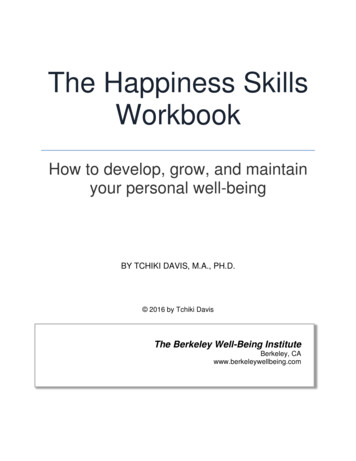

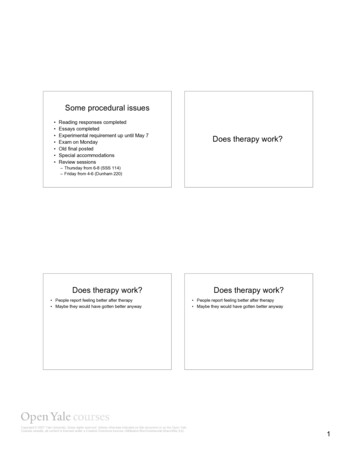
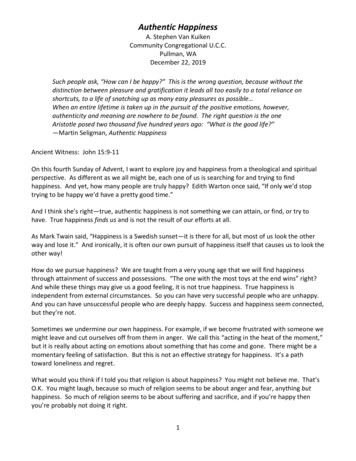
![INDEX [ actmindfully .au]](/img/14/2016-complete-worksheets-for-russ-harris-act-books.jpg)
![INDEX [thehappinesstrap ]](/img/14/complete-worksheets-2014.jpg)
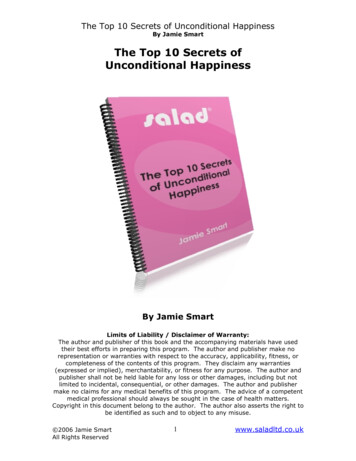
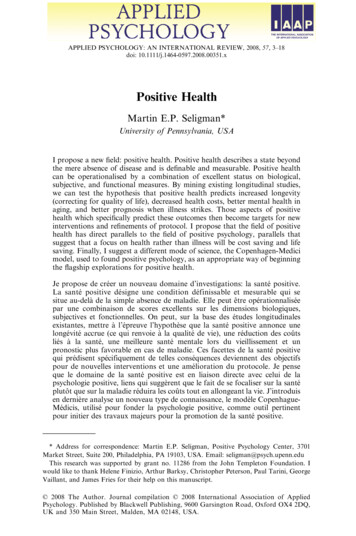
![Does transition make you happy? [EBRD - Working papers]](/img/15/wp0091.jpg)


